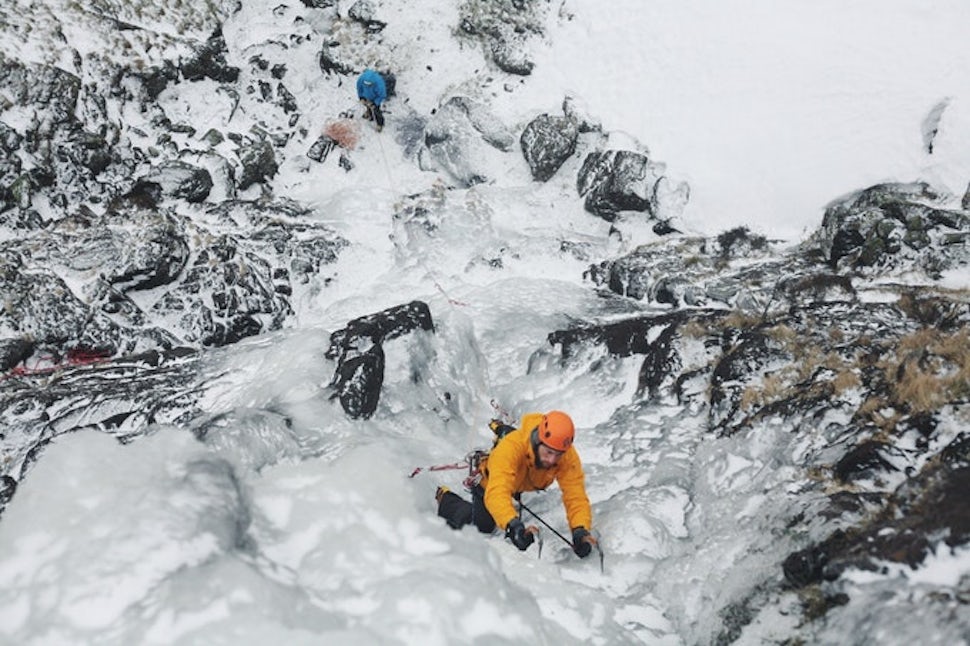5 Tips for Getting Adventurous Ice Climbing Photos

The holy grail of Lakes winter climbing?
I've never climbed a frozen waterfall. For people in places of a colder climate, this opportunity must come around a lot more. Meanwhile, I sit around and scroll through the endless images of perfect icefalls in Alaska and Canada amongst others. Here in the Lakes, the winters are a battle. Waiting for good conditions can feel like an impossible feat...
You can imagine my excitement when I heard whispers that routes may be in here in the Lakes. One friend to another the word spreads. We caught wind and with good weather packed our bags to see for ourselves.
Since moving to the Lakes and starting to take photos, I've had a kind of bucket list of shots I've wanted to get. One of those, to get a photo of climbers on a frozen waterfall in the Lake District. I only hope we don't have to wait another 5 years before I get a chance to do it again.
From one beginner to another
Since spending more time taking photos in the outdoors, I've found most days out are a huge learning curve. Here are some things that I've found useful getting shots of winter climbing and summer climbing too.
1. Patience is key.
With winter here in the UK being temperamental, being able to make the most of the weather is a big factor on getting stuff done. Do your research, Make yourself available and grabbing your kit and going when the time is right is all just part of it. Don't wait for winter to come to you, get out there and find it.
2. Strength in numbers
Getting good photos of people climbing in summer or winter can be a tricky thing. Climbing as a pair and taking photos that way can be great. When you can, removing yourself from the climb itself can give you even better results and bring in really exciting perspectives. Where routes and crags allow, setting up an abseil rope out of the way and shooting a pair of climbers is my preferred way to get shots. As you will be moving in the opposite direction to the climbers, I usually get photos of the top half of the climb with the person leading and then get lower down when the second sets off for a different angle. A good solid understanding of rigging and abseiling is obviously essential if you do use this method.
3. Stay warm
Winter climbing can be a slow progress. Once in place on your abseil rope or at the bottom of the climb you could be sat around for a long time. Hat, gloves, thermals, a flask, food and plenty of belay jackets are essential. If you are hanging on a rope make sure you have access to these too. I usually take a bag with me, filled with all the kit I need. Battery life can also deplete fast in the cold. Keeping your phone and spare camera batteries in a pocket close to your body will help to keep them alive a little bit longer.
4. Be the early birds
When routes come in here in the UK they get very popular fast. Getting to a route before the crowds will give you a much more relaxed experienced and save you from possibly rushing your shots. It's also just polite if you're going to be setting up ropes and potentially staging photos, literally 'hanging around'.
5. Enjoy it!
The whole time I was out getting these photos I had to keep pinching myself. Being out and experiencing such a unique way of climbing is what its all about. If you cant get the photos you want this time, there will be another opportunity. Don't forget why you're out in the first place.
We want to acknowledge and thank the past, present, and future generations of all Native Nations and Indigenous Peoples whose ancestral lands we travel, explore, and play on. Always practice Leave No Trace ethics on your adventures and follow local regulations. Please explore responsibly!
Do you love the outdoors?
Yep, us too. That's why we send you the best local adventures, stories, and expert advice, right to your inbox.












